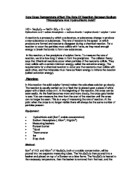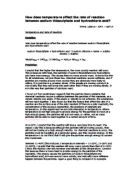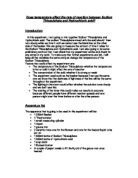Heat Energy Kinetic Energy
Therefore I hypothesize that as I increase the temperature; the rate of reaction will increase.
Apparatus
The apparatus that follows is what I will need to carry out my experiment and take some results:
- Sodium thiosulphate solution
- Hydrochloric acid
- Conical flask
- Thermometer
- Measuring cylinder
- Heat proof mat
- Bunsen burner
- Wire gauze
- Tripod
-
Stop watch
- White tile (with cross)
Diagram
Method
Before anything I made the proper safety precautions by wearing my safety goggles to protect my eyes.
Secondly, I had to setup the chemicals. This involved me putting 50ml of sodium thiosulphate in a conical flask and on top of a gauze and tripod with a Bunsen burner directly underneath. Then I measured out 10ml of hydrochloric acid into a measuring cylinder and waited until the sodium thiosulphate was at the correct temperature. When this was ready I poured the Hydrochloric acid in immediately started the timer and held the mixture over the tile with the cross. I knew that I could stop the clock when I could no longer see the cross through the mixture. The experiment was repeated a further more times so I could get an accurate average to make up for any slight miscalculations. I then proceeded to put all of my results into a table, which I used to draw up my graphs. Fair testing was inevitable for accurate results. Many things were taken into account when doing the experiment like for example:
- All equipment was kept constant, e.g. volume of conical flask,
- Room temperature,
- Concentration of acid,
- Amount of chemicals,
- Contamination of chemicals.
To combat each of these I made sure that I wrote down the constant values I used in the first experiment and repeated these values in all the following ones. Checked to see if the room temperature varied about or below 2˚C from the temperature at the start of the first experiment. Finally I made sure that all beakers, flasks or measuring devices were cleaned and dried before being re-used to minimize contamination between chemicals.
Results
I have put all of my results into tables and then into graphs (see attached graphs). They are arranged so that each experiment is shown against the time in seconds:
Room Temperature
Time (seconds)
30˚C
40˚C
50˚C
60˚C
70˚C
80˚C
Result Analysis
There is a considerable amount of change between the room temperature reaction, and the one at 80˚C. This is because (as I explained in my research) the more kinetic energy that the particles have, the more that they will collide. It is this collision of particles that causes reactions to occur. As the sodium thiosulphate particles collide with the hydrochloric acid particles they react to form sodium chloride, water, sulphur and sulphur dioxide. The balanced symbol equation is shown below:
Na2S2O3(aq) + 2HCL(aq) 2NaCL(aq) + SO2(g) + S(s)
The solid formed (sulphur) is what made the liquid turn cloudy, this is called a precipitate reaction. I did not detect any heat, suggesting that the reaction was not exothermic.
Conclusion
I have found that my hypothesis that as the temperature increased so would the rate of reaction. This is explained through activation energy. As I said in my hypothesis, the activation energy is the minimum amount of energy needed for two products to react. As more energy is added to the products reacting, the less time it will take the substances to react. This is because the particles move quicker and have more energy enabling them to react faster. In total between the coldest and hottest recorded temperature, the difference is on average 30.84 seconds. This proves that as more heat energy is introduced, more kinetic energy is transferred meaning less reaction time. In addition, I noticed from my results that as the temperature went over 50˚C the rate of the reaction leveled-out. This can be explained, as the products reached an optimum temperature the kinetic energy had little effect because there is a limit to how fast two products can react.
Evaluation
I think the experiment was successful. I might have been able to improve my results by using more finely tuned equipment or repeating the experiment more times. I encountered 1 anomaly in my results, and this may be explained by the only drawback in the result accuracy: human error when operating the stopwatch.
I feel I could do more to expand on the original question set by perhaps doing other experiments linking with this one like looking at for example:
- Concentration,
- Pressure,
- A catalyst.
I may have been able to study concentration; the more concentrated a product is the more particles there are to react in the same volume. Therefore, the products will collide more and react faster. Pressure will cause the particles to be forced closer together and therefore react faster. Finally, a catalyst will increase the rate of reaction by making the products react quicker while not reacting or breaking down itself. This can be very useful as it can be used over and over again.







